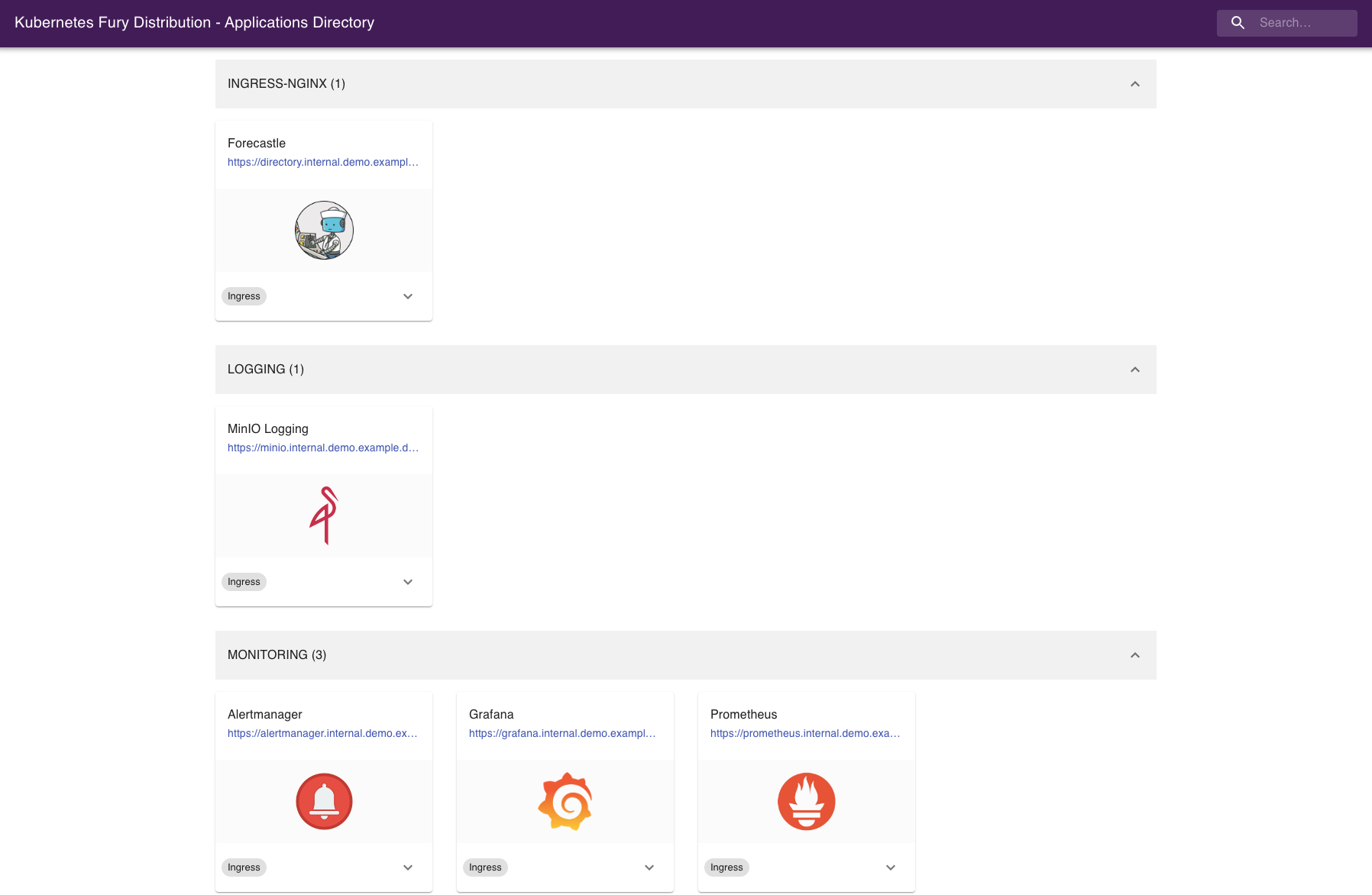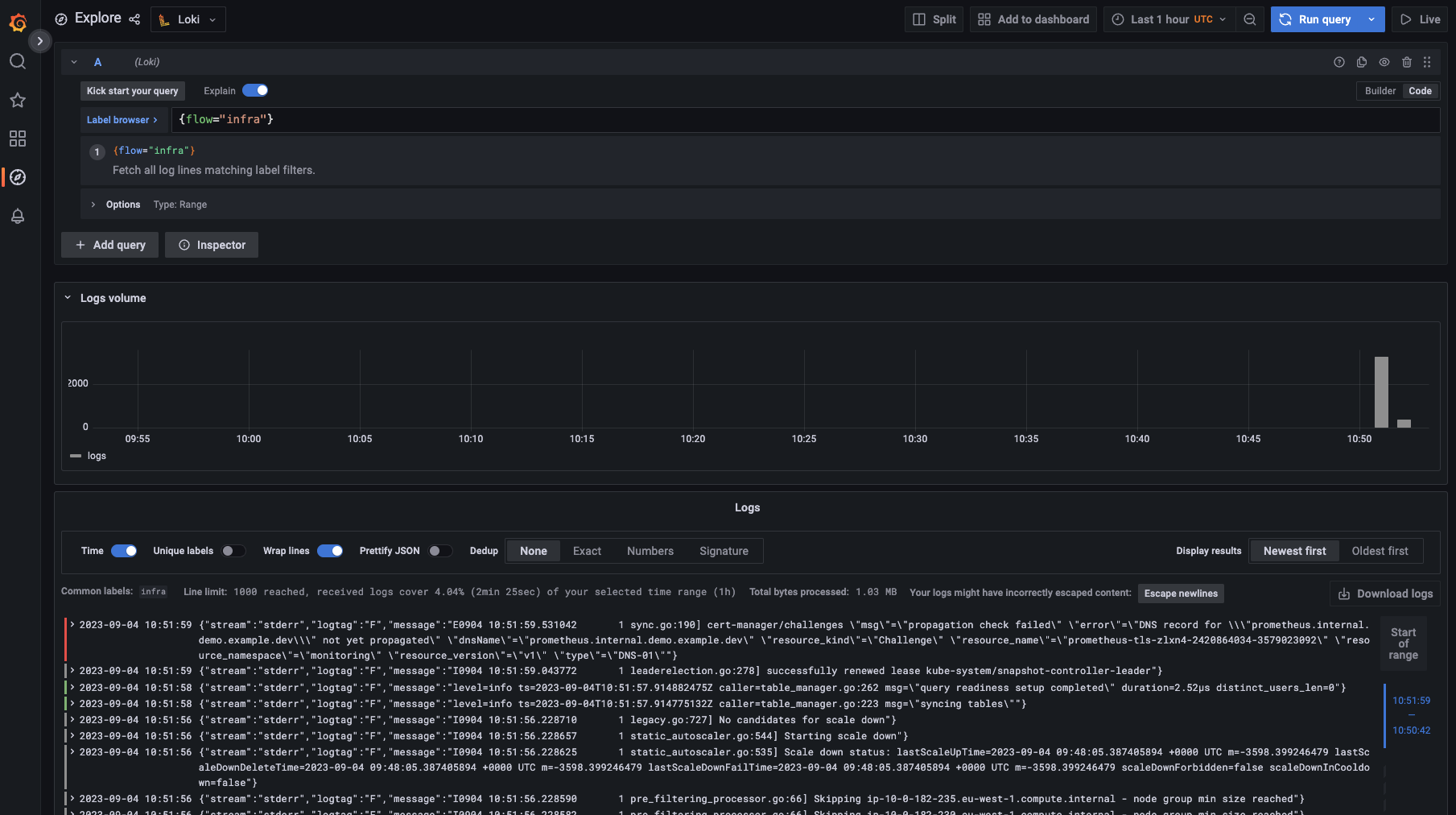Fury on minikube
This step-by-step tutorial helps you deploy a subset of the Kubernetes Fury Distribution on a local minikube cluster.
This tutorial covers the following steps:
- Deploy a local minikube cluster.
- Download the latest
furyctlCLI. - Install Fury distribution using
furyctlCLI. - Explore some features of the distribution.
- Teardown the environment.
☁️ If you prefer trying Fury in a cloud environment, check out the Fury on EKS tutorial.
The goal of this tutorial is to introduce you to the main concepts of KFD and how to work with its tooling.
Prerequisites
This tutorial assumes some basic familiarity with Kubernetes.
To follow this tutorial, you need:
- minikube - follow the installation guide. You can run the minikube cluster with one of the drivers listed.
- kubectl - to interact with the cluster.
Setup and initialize the environment
-
Open a terminal
-
Clone the fury getting started repository containing all the example code used in this tutorial:
git clone https://github.com/sighupio/fury-getting-started/
cd fury-getting-started/fury-on-minikube
Step 1 - Start the minikube cluster
-
Start minikube cluster:
export REPO_DIR=$PWD
export KUBECONFIG=$REPO_DIR/kubeconfig
minikube start --kubernetes-version v1.28.15 --memory=16384m --cpus=6⚠️ This command will spin up by default a single-node Kubernetes v1.28.15 cluster, using the default driver, with 6 CPUs, 16GB RAM and 20 GB Disk.
-
Test the connection to the minikube cluster:
kubectl get nodesOutput:
NAME STATUS ROLES AGE VERSION
minikube Ready control-plane 9s v1.28.15
Step 3 - Install furyctl
Install furyctl binary following the instructions in furyctl's documentation.
Step 3 - Installation
In this directory, an example furyctl.yaml file is present.
furyctl will use the provider KFDDistribution that will install only the Distribution on top of an existing cluster.
apiVersion: kfd.sighup.io/v1alpha2
kind: KFDDistribution
metadata:
name: fury-local
spec:
distributionVersion: v1.28.6
distribution:
kubeconfig: "{env://KUBECONFIG}"
modules:
networking:
type: none
ingress:
baseDomain: demo.example.internal
nginx:
type: single
tls:
provider: certManager
certManager:
clusterIssuer:
name: letsencrypt-fury
email: example@sighup.io
type: http01
logging:
type: loki
loki:
tsdbStartDate: "2024-12-03"
monitoring:
type: prometheus
policy:
type: none
dr:
type: none
velero: {}
auth:
provider:
type: none
customPatches:
patchesStrategicMerge:
- |
$patch: delete
apiVersion: logging-extensions.banzaicloud.io/v1alpha1
kind: HostTailer
metadata:
name: systemd-common
namespace: logging
- |
$patch: delete
apiVersion: logging-extensions.banzaicloud.io/v1alpha1
kind: HostTailer
metadata:
name: systemd-etcd
namespace: logging
- |
$patch: delete
apiVersion: apps/v1
kind: DaemonSet
metadata:
name: x509-certificate-exporter-control-plane
namespace: monitoring
In this example, we are installing the distribution with the following options:
- No CNI installation, minikube comes with a CNI by default
- A single battery of nginx
- Loki as storage for the logs
- No gatekeeper installation
- No velero and DR installation
- No Auth on the ingresses
- Disabled some logging extensions due to minikube incompatibilities
- Disabled master certificate-exporter, due to minikube incompatibilities
ℹ️ Usually, when using the dual ingress controller, the
internal.<ingress domain>base domain is specified. For this occurence, since there is just a single NGINX Ingress (for the purposes of this guide), only the ingress base domain is configured. Both, single or dual ingress configuration, are valid. Feel free to edit the furyctl.yaml file according to your needs. For more information see Ingress NGINX Dual and Ingress NGINX Single documentation pages.
Execute the installation with furyctl:
furyctl apply --outdir $PWD
⏱ The process will take some minutes to complete, you can follow the progress in detail by running the following command:
tail -f .furyctl/furyctl.<timestamp>-<random-id>.log | jq
--outdirflag is used to define in which directory to create the hidden.furyctlfolder that contains all the required files to install the cluster. If not provided, a.furyctlfolder will be created in the user home.
The output should be similar to the following:
INFO Downloading distribution...
INFO Validating configuration file...
INFO Downloading dependencies...
INFO Validating dependencies...
INFO Running preflight checks
INFO Checking that the cluster is reachable...
INFO Cannot find state in cluster, skipping...
INFO Running preupgrade phase...
INFO Preupgrade phase completed successfully
INFO Installing Kubernetes Fury Distribution...
INFO Checking that the cluster is reachable...
INFO Checking storage classes...
INFO Checking if all nodes are ready...
INFO Applying manifests...
INFO Kubernetes Fury Distribution installed successfully
INFO Applying plugins...
INFO Skipping plugins phase as spec.plugins is not defined
INFO Saving furyctl configuration file in the cluster...
INFO Saving distribution configuration file in the cluster...
🚀 The (subset of the) distribution is finally deployed! In this section you will explore some of its features.
Step 4 - Explore the distribution
Setup local DNS
In Step 3, alongside the distribution, you have deployed Kubernetes ingresses to expose underlying services at the following HTTP routes:
directory.demo.example.internalgrafana.demo.example.internalprometheus.demo.example.internal
To access the ingresses more easily via the browser, configure your local DNS to resolve the ingresses to the external minikube IP:
ℹ️ the following commands should be executed in another terminal of your host. Not inside the fury-getting-started container.
-
Get the address of the cluster IP:
minikube ip
<SOME_IP> -
Add the following line to your local
/etc/hosts:<SOME_IP> directory.demo.example.internal grafana.demo.example.internal prometheus.demo.example.internal
Now, you can reach the ingresses directly from your browser.
ℹ️ Note
If you are running minikube on macOS or Windows using Docker Desktop, you will need to port-forward the NGINX Ingress ports to localhost to enable access to your exposed applications. For example, you can run:
kubectl port-forward service/ingress-nginx -n ingress-nginx 31080:80 31443:443
# Output:
Forwarding from 127.0.0.1:31080 -> 8080
Forwarding from 127.0.0.1:31443 -> 8443This command will forward both HTTP and HTTPS ports of the NGINX Ingress Controller to your localhost on ports 31080 and 31443 respectively. Leave that terminal window open while you need access to your applications. Inside your /etc/hosts file you can put 127.0.0.1 in place of minikube's IP.
Forecastle
Forecastle is an open-source control panel where you can access all exposed applications running on Kubernetes.
Navigate to https://directory.demo.example.internal:31443 to see all the other ingresses deployed, grouped by namespace.

Grafana
Grafana is an open-source platform for monitoring and observability. Grafana allows you to query, visualize, alert, and understand your metrics.
Navigate to https://grafana.demo.example.internal:31443 or click the Grafana icon from Forecastle (remember to append the port 31443 to the url).
Discover the logs
Navigate to grafana, and:
- Click on explore
- Select Loki datasource
- Run your query!
This is what you should see:

Discover dashboards
Fury provides some pre-configured dashboards to visualize the state of the cluster. Examine an example dashboard:
- Click on the search icon on the left sidebar.
- Write
podsand click enter. - Select the
Kubernetes/Podsdashboard.

Make sure to select a namespace that has pods running and then select one of those pods.
Take a look around and test the other dashboards available.
Step 6 - Tear down
-
Delete the minikube cluster:
minikube delete
Conclusions
Congratulations, you made it! 🥳🥳
We hope you enjoyed this tour of Fury!
Issues/Feedback
In case you ran into any problems feel free to open an issue in GitHub.
Where to go next?
More tutorials: